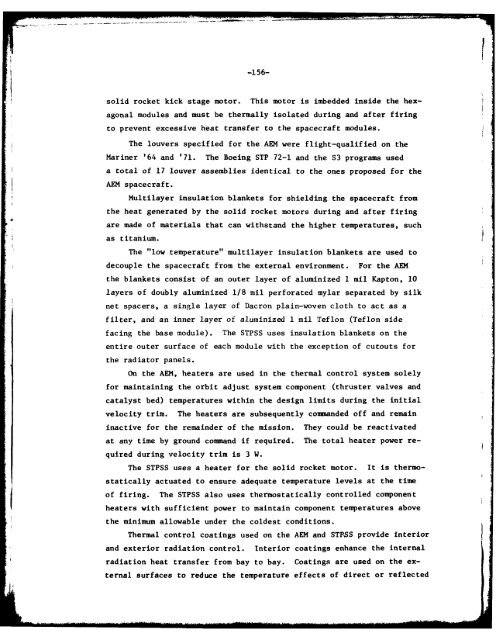A Case Study in NASA-DoD - The Black Vault
A Case Study in NASA-DoD - The Black Vault
A Case Study in NASA-DoD - The Black Vault
You also want an ePaper? Increase the reach of your titles
YUMPU automatically turns print PDFs into web optimized ePapers that Google loves.
-156-<br />
*as<br />
solid rocket kick stage motor. This motor is imbedded <strong>in</strong>side the hexagonal<br />
modules and must be thermally isolated dur<strong>in</strong>g and after fir<strong>in</strong>g<br />
to prevent excessive heat transfer to the spacecraft modules.<br />
<strong>The</strong> louvers specified for the AEM were flight-qualified on the<br />
Mar<strong>in</strong>er '64 and '71. <strong>The</strong> Boe<strong>in</strong>g STP 72-1 and the S3 programs used<br />
a total of 17 louver assemblies identical to the ones proposed for the<br />
AEM spacecraft.<br />
Multilayer <strong>in</strong>sulation blankets for shield<strong>in</strong>g the spacecraft from<br />
the heat generated by the solid rocket motors dur<strong>in</strong>g and after fir<strong>in</strong>g<br />
are made of materials that can withstand the higher temperatures, such<br />
titanium.<br />
<strong>The</strong> "low temperature" multilayer <strong>in</strong>sulation blankets are used to<br />
decouple the spacecraft from the external environment. For the AEM<br />
the blankets consist of an outer layer of alum<strong>in</strong>ized 1 mil Kapton, 10<br />
layers of doubly alum<strong>in</strong>ized 1/8 mil perforated mylar separated by silk<br />
net spacers, a s<strong>in</strong>gle layer of Dacron pla<strong>in</strong>-woven cloth to act as a<br />
filter, and an <strong>in</strong>ner layer of alum<strong>in</strong>ized 1 mil Teflon (Teflon side<br />
fac<strong>in</strong>g the base module). <strong>The</strong> STPSS uses <strong>in</strong>sulation blankets on the<br />
entire outer surface of each module with the exception of cutouts for<br />
the radiator panels.<br />
On the AEM, heaters are used <strong>in</strong> the thermal control system solely<br />
for ma<strong>in</strong>ta<strong>in</strong><strong>in</strong>g the orbit adjust system component (thruster valves and<br />
catalyst bed) temperatures with<strong>in</strong> the design limits dur<strong>in</strong>g the <strong>in</strong>itial<br />
velocity trim. <strong>The</strong> heaters are subsequently commanded off and rema<strong>in</strong><br />
<strong>in</strong>active for the rema<strong>in</strong>der of the mission. <strong>The</strong>y could be reactivated<br />
at any time by ground command if required. <strong>The</strong> total heater power required<br />
dur<strong>in</strong>g velocity trim is 3 W.<br />
<strong>The</strong> STPSS uses a heater for the solid rocket motor. It is thermostatically<br />
actuated to ensure adequate temperature levels at the time<br />
of fir<strong>in</strong>g. <strong>The</strong> STPSS also uses thermostatically controlled component<br />
heaters with sufficient power to ma<strong>in</strong>ta<strong>in</strong> component temperatures above<br />
the m<strong>in</strong>imum allowable under the coldest conditions.<br />
<strong>The</strong>rmal control coat<strong>in</strong>gs used on the AEM and STPSS provide <strong>in</strong>terior<br />
and exterior radiation control. Interior coat<strong>in</strong>gs enhance the <strong>in</strong>ternal<br />
radiation heat transfer from bay to bay. Coat<strong>in</strong>gs are used on the external<br />
surfaces to reduce the temperature effects of direct or reflected
















